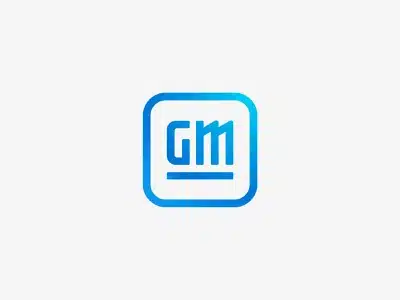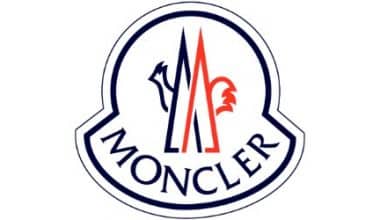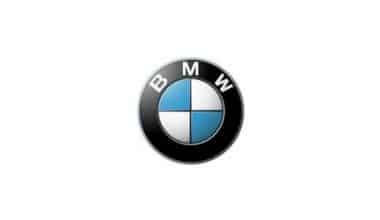The General Motors logo has evolved over the years, reflecting the company’s changing identity and values. In this article, we will take a look at the history of the GM logo, from its humble beginnings to its current sleek and modern design. We will also discuss the meaning of the logo and its significance to the company.
Overview
The “Mark of Excellence” emblem from General Motors (GM) is widely regarded as one of the most instantly recognizable and memorable vehicle logos of all time. While blue in the logo represents GM’s excellence and dependability, white represents its purity, integrity, and charm.
Bianca Iacopelli, GM’s graphic designer, created the current GM logo. She comes from an artistic family. Her mother is a well-known illustrator, but her grandfather is a talented sculptor and painter. Iacopelli, 29, began drawing at the age of five and, given her ancestors, found her calling early.
GM announced in early 2021 that the company’s impressive, iconic GM logo would be changed after more than 50 years. The current GM logo reflects the automaker’s transition into the world of electric vehicles.
In this new logo, the letter “M” appears in a brighter sky blue and is depicted as an electric cord plug. This is done tastefully to represent the company moving forward and forward-looking. Furthermore, the new logo is being used with a new promotional campaign dubbed “Everybody In.”
What is the company symbol of General Motors?
General Motors Company’s symbol is based on a stylized letter “M” in lowercase, representing the company’s transition to the electric vehicle market, as the character resembles an electric plug. The symbol is a lowercase “GM” abbreviation drawn on a white background and enclosed in a thick square frame with rounded corners.
Brief History
In the early 1900s, entrepreneur William Durant owned the Durant-Dort Carriage Company, which produced horse-drawn transportation and was a market leader in its field. She was in Flint, Michigan, at the time. The Flint Wagon Works owner, James H. Whiting, sold him the Buick Motor Company in 1904. The new owner then enlisted his business partner, Charles Stewart Mott, and established the General Motors Company holding company four years later. He and General Electric had previously agreed on a name.
Buick was the company’s first acquisition. It then purchased Oakland (Pontiac’s predecessor) and the brands Elmore, Cadillac Reliance Motor Truck, and Rapid Motor Vehicle (GMC’s predecessor). An attempt was made a year later to acquire the Ford Motor Company. For the transactions, GM’s CEO obtained loans from banks, which succumbed to the 1910-1911 panic and demanded that Durant be removed from office because, according to bankers, the company was too young and could not handle loan repayment. The Board of Directors followed her instructions.
Read Also: Spider-Man Logo: Evolution, History, Meaning
William Crapo rejoined the automobile industry, co-founding Chevrolet Motor Company with Swedish race car driver Louis Chevrolet. He had been in charge since 1915, and in 1916, GM re-registered the General Motors Corporation. A year later, the founder of the successful Chevrolet Motor Company purchased a controlling stake. He merged the two companies in the spring of 1918, retaining GM. However, two years later, Durant was deposed and replaced by Alfred P. Sloan, who had supported the General Motors purchase.
The new leader instituted a rule requiring a change in car style every year and the most recent pricing strategy, which ranked all models according to a cost grid. That is, they separated the expensive and low-cost series. His policies led to the company’s heyday when it occupied more than half of the US car market and was the largest manufacturer from 1931 to 2007. Naturally, each stage of the organization was reflected in its identity, which changed seven times.
The Evolution of the GM Logo
The General Motors logo is well-known for its clarity and simplicity. As one of the most memorable and recognizable motor vehicle logos ever, GM’s visual identity has helped the company achieve record-high sales over the years. Here’s a look at how the GM logo has changed over time.
1908 – 1938
The original GM logo was designed in 1908 and was very simple during the company’s early years. Instead of a graphic symbol, it looked like an information plate with necessary information like the name, registration date, foundation year, etc. The logo was created with black letters on a white background.
1938 – 1964
General Motors received its first real logo design in 1938, a double-color vertical rectangle with two sections.
The upper larger section featured the logotype “GM,” an abbreviation for the company’s full name. The letters were large and elegant, written in a serif font and painted white on a black background.
On the other hand, the smaller lower section had “General Motors” in black, written in uppercase in two lines. This wordmark was created in a more modern and smooth sans-serif font to complement the emblem’s classic style.
This logo design was laconic and minimalist, representing a powerful automaker company and conveying a sense of stability and authority.
1964-1967
In 1964, GM’s first actual logo was redesigned for the first time. In the updated version, the designers chose the acronym “GM” and moved the full name outside the square.
The letter “GM” was in the center of a square with two blue and white striped borders. The designers used a different font for the acronym, removing the serifs and adding a “G” curly feature at the bottom.
1967 – 2001
In 1967, the General Motors logo was redesigned for the third time. It became more minimalistic and straightforward. It was a blue square with rounded corners and a white underlined “GM” wordmark. This wordmark was simply “GM” lettering in a classic Helvetica font.
This period’s logo design was used for a long time. This design was straightforward because the designers removed the majority of the elements. All that remained was the acronym and a white underline against a blue background. The designers also removed the square’s borders.
2001-2010
In 2001, GM unveiled a new logo design, a glossy version of the emblem that had been in use since 1967. This design was made up of a 3D frame that resembled a ledge with borders. The logo was divided into two sections by a horizontal wave in the middle against “GM’s” background. Both the background and the letters have a gradient.
2010-2021
In 2001, the designers gave the emblem a metallic color and increased the 3D effect. The logo gained volume due to the reorganization of highlights and shadows. While the color was reduced, the gradient remained on the square and letters.
2011-2021
Furthermore, General Motors used a simpler wordmark. The company’s full name was written in a low-key sans font with vaguely rounded corners.
2021-Present
General Motors significantly altered its logo design for the first time in nearly 60 years, focusing on cutting-edge technology and sustainability. With its emblem, the automaker emphasized its focus on producing electric vehicles. The acronym “GM” is written in lowercase letters and placed in a square with rounded corners in the new version.
This super-soft design in white and blue highlights the car manufacturer’s desire to preserve the environment by protecting the air, clouds, and sky. The letter “m” was designed to look like an electrical cord plug.
In addition, there is an underline beneath the letters that represent an impromptu socket. In addition to the letter “m,” there is a letter “g” with a shortened tail that appears harmonious in height.
Color and Font
The bold stylized lowercase lettering from General Motors’ primary logo is set in a heavy and voluminous custom sans-serif typeface with attractive futuristic character contours. The closest fonts to the designer one used in this logo are most likely Venus Envy Regular or Deportivo a Regular but with some contour changes.
General Motors’ visual identity’s color palette is based on glossy gradient shades of blue that range from deep and dark at the bottom of the letters to bright and vivid sky blue at the top. Blue is a color associated with confidence, dependability, and security, and technological and medical companies frequently use it due to the associations it evokes.
The Evolution of the GM Brand
The General Motors Company, also known as General Motors (GM), is an American automobile manufacturer that was the world’s largest carmaker for most of the 1900s and early 2000s.
It operates manufacturing and assembly plants, as well as distribution centers, throughout the United States, Canada, and several other countries around the world. The primary products of General Motors are trucks and automobiles, engines, and automotive components. The company, headquartered in Detroit, Michigan, also provides financial services.
History from the Beginning
General Motors Company was founded in 1908 by William C. Durant to consolidate several motorcar companies producing Buick, Cadillac, Oldsmobile, Oakland (later Pontiac), Marquette, Ewing, and other vehicles, as well as Rapid and Reliance trucks.
In 1912, GM commercially introduced the electric self-starter in its Cadillac model, which quickly rendered the hand crank obsolete. The headquarters of GM remained in Detroit, Michigan, and the company was reincorporated and renamed General Motors Corporation in 1916. Delco Products and Chevrolet joined General Motors in 1918. Frigidaire and the Fisher Body Company followed suit a year later (the former was acquired in 1979).
Durant was fired from GM in 1929, and Alfred P. Sloan, Jr. took over. He was the company’s president from 1923 to 1937 and then Chairman from 1937 to 1956. Sloan transformed General Motors from a disjointed, uncoordinated collection of business entities into a unified enterprise comprised of five major automotive divisions—Buick, Cadillac, Chevrolet, Oldsmobile, and Pontiac—whose operations were overseen by a central company office staffed with significant financial and advisory personnel.
Within an overall policy framework, the various automotive divisions retained significant independence. Large-scale industrial companies in the United States quickly adopted the decentralized management concept. Sloan also strengthened General Motors’ sales organization, initiated annual style car model changes, and implemented consumer financing changes.
By 1929, General Motors had surpassed Ford to become the leading passenger car manufacturer in the United States. It expanded its international operations, including Vauxhall in England in 1925, Adam Opel in Germany in 1929, and Holden in Australia in 1931.
Read Also: Nerf Logo: History, Evolution & All You Need
In 1925, the Yellow Truck and Coach Manufacturing Company (now GMC Truck and Coach Division) was one of the new GM divisions and subsidiaries in the United States. General Motors overtook Ford as the world’s largest automaker in 1931. By 1944, GM had become one of the world’s largest industrial corporations, producing 44% of all cars manufactured in the United States.
Throughout the 1950s and 1960s, General Motors grew alongside the US economy, accounting for 40%-45% of total US automotive sales. GM purchased Electronic Data Systems, a significant data processing company, in 1984 and Hughes Aircraft Co., a manufacturer of communication satellites and weapon systems, in 1986.
Throughout the 1970s and 1980s, General Motors and other American automobile manufacturers faced increasing competition from Japanese vehicle manufacturers. As a result, in 1984, GM launched a new vehicle division called Saturn, which used highly automated factories to produce subcompact cars to compete with Japanese imports.
Although General Motors’ modernization efforts yielded some results, massive losses in the early 1990s forced the automaker to close many plants and lay off tens of thousands of workers.
By the mid-1990s, GM had made a strong recovery and refocused on its automotive businesses, as did other US automakers. In 1996, the company sold Electronic Data Systems. In 1997, it sold its Hughes Electronics defense units, exiting the defense-aerospace and computer services industries to focus on its car-making operations.
GM completed its acquisition of Saab Automobile AB in 2000. By the early 2000s, GM owned a stake in several automakers, including Fiat, Subaru, Suzuki, and Isuzu. However, in 2004, the company dropped the Oldsmobile brand. Toyota Motor Corporation surpassed General Motors as the world’s largest automaker 2008.
Bankruptcy and Bailout of General Motors
The “Big Three” automakers—General Motors, Ford, and Chrysler LLC—were in financial trouble by 2008. Thus, in December of the same year, President George W. Bush announced an emergency monetary rescue program to bail out the automakers and save America’s struggling automotive industry.
The plan provided automakers with $13.4 billion in government loans right away. The loans would allow the automakers to continue operations until March 2009, when they would be required to demonstrate their “financial viability” or repay the loan within 30 days.
Furthermore, the companies were required to undergo restructuring. The government loan was initially offered to Chrysler LLC and General Motors; Ford claimed it had sufficient funds to continue operations and thus did not apply for the government loan.
As GM’s financial problems worsened, the automaker claimed to be in debt of $173 billion. As a result, the company declared bankruptcy in June 2009. A month later, it emerged from bankruptcy reorganization.
General Motors sold Saab Automobile AB in 2010 and officially ended the Saturn and Pontiac brands. The company’s automotive divisions were reduced to four: GMC, Chevrolet, Cadillac, and Buick. In November of the same year, GM launched one of American history’s largest initial public offerings (IPOs). In 2011, General Motors reclaimed its world-leading position as the world’s largest automaker.
Read Also: GrubHub Logo: Did Grubhub Change its Logo?
However, General Motors’ strong recovery was harmed in 2014 when it was revealed that the company had covered up that many GM car models had defective ignition switches; the faulty component was believed to have caused over 120 deaths.
General Motors received widespread praise for handling the scandal, and the company posted impressive revenue, with record sales between 2014 and 2016. However, its European division continued to struggle, and Vauxhall and Opel were sold in 2017 to the PSA Group, the French manufacturer of Citroen and Peugeot vehicles.
The deal, worth over $2 billion, was regarded as the end of General Motors’ European operations.
Conclusion
General Motors Company, colloquially known as General Motors, is a multinational corporation based in the United States that designs manufactures, sells, and distributes automobiles, parts, and financial services.
General Motors, founded in Flint, Michigan 1908, is headquartered in Detroit, Michigan, and employs at least 284,000 people worldwide. The company manufactures vehicles in 33 countries around the world.
GM produced over 9 million cars and trucks worldwide in 2009 under Buick, GMC, Cadillac, Chevrolet, Hummer, Holden, Pontiac, Opel, Saturn, Vauxhall, and Saab.
GM owns a majority stake in South Korea’s GM Daewoo Auto and Technology and has manufacturing and technology joint ventures with several automakers worldwide.
GM Logo: Related Articles
- EBAY LOGO: Meaning, Font, and History
- CHEVROLET: History Timeline, Logo and Success Story
- CHEVROLET LOGO: Meaning, What It Is Known For and History
- BUICK LOGO: Meaning, Old Logo, & History






